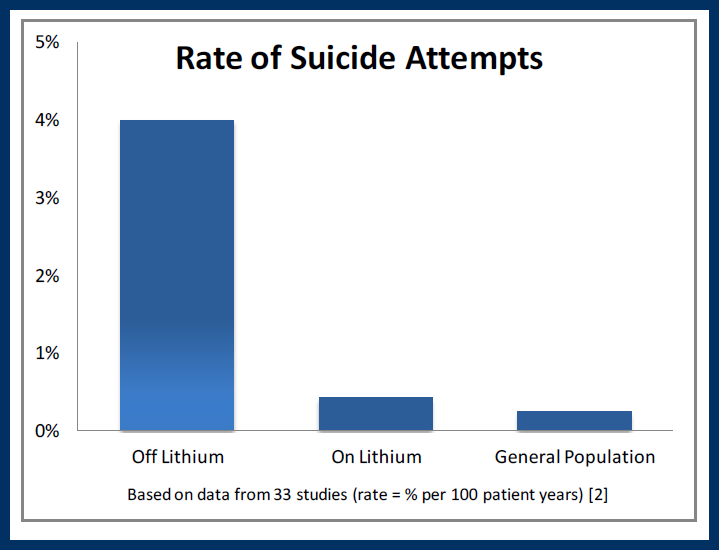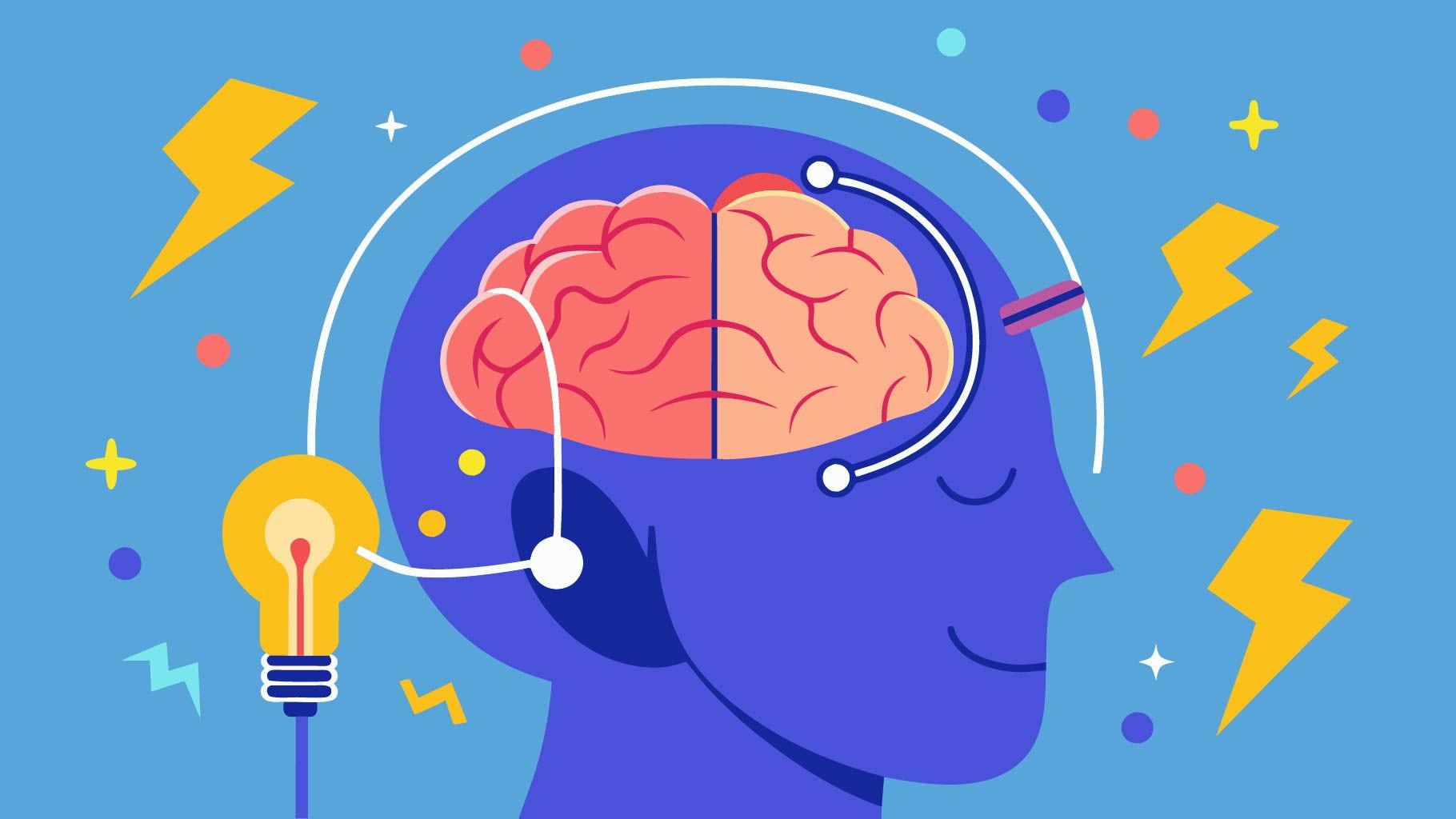Article
The Year in Bipolar: 7 Practice-Changing Papers From 2017
Author(s):
Among the topics covered in this year's noteworthy studies: lithium and suicide prevention, mixed depression, and light therapy.
Figure. Rate of suicide attempts

1. Confirmed: Lithium prevents suicide
What it showed
Lithium can prevent 12% of suicides in patients with bipolar disorder.[1]
How it adds to our knowledge
The suicide rate is elevated 10-fold in patients with recurrent mood disorders, and epidemiologic studies suggest that lithium lowers that risk to a level comparable to that in the general population (Figure).[2] What those studies have lacked is a controlled design, but controlled trials are usually underpowered to detect rare events like suicide. This new study bridges that gap by combining a large cohort (50,000 patients over an 8-year period) and a case-control design in which each patient served as his or her own control. The anti-suicide effects were unique to lithium and not seen with valproate. Lithium even lowered the suicide risk among patients with features thought more responsive to valproate (eg, mixed states, rapid cycling, and comorbid substance abuse).
How it changes practice:
Concerns about overdose on lithium often limit its use in suicidal and impulsive patients, but that practice does not remove the means of suicide and instead may rob those patients of a treatment that can prevent those dangerous impulses. Lithium can prevent suicide even when it does not improve mood, and it should be considered for all bipolar and unipolar patients with elevated risks of suicide.[2] Abrupt discontinuation of lithium can significantly raise the suicide risk, so the medicine should be tapered slowly over several months.[1]
2. Nearly a quarter of depressed patients convert to bipolar disorder
What it showed
22% of patients with a diagnosis of major depression develop bipolar disorder over a follow-up of 12-18 years, and most of those conversions occur within the first 5 years of diagnosis.[3]
How it adds to our knowledge
By pooling data from 56 studies, this meta-analysis offers a clearer picture of the conversion from unipolar to bipolar disorder. Patients at greater risk include those with a family history of bipolar disorder, early-onset depression, psychotic features, comorbid disorders (especially ADHD, social anxiety, childhood trauma), and subthreshold manic symptoms.
How it changes practice
Screening for bipolar disorder should be ongoing and take into account symptoms as well as non-symptomatic markers of the illness. Tools like the Bipolarity Index can help clinicians gather that data and estimate the risk of a bipolar diagnosis.
3. Manic symptoms during unipolar depression are more common than thought
What it showed
Depressions with at least 3 manic symptoms are common in both unipolar (24%) and bipolar (35%) depressions.[4]
How it adds to our knowledge
Though long recognized as part of the bipolar spectrum, mixed features are a new concept in DSM-5. This meta-analysis, which included over 19,000 patients, tells us that a surprising 24% of unipolar patients have subsyndromal manic features.aHow it changes practice
Recognizing mixed depression can help identify patients who are at risk for worsening on antidepressants and for conversion to bipolar disorder. A new treatment guideline warns against antidepressant monotherapy in mixed depression, even when the diagnosis is unipolar.[5]
a DSM-5 takes a more conservative approach to mixed features than the studies in this paper (it does not allow irritability, distractibility, or psychomotor agitation to count toward the diagnosis).
4. Psychotherapy for bipolar disorder: Bring the family in
What it showed
Psychotherapy for bipolar disorder is more effective at reducing relapses when family or other caregivers are included in the work.[6]
How it adds to our knowledge
By using network meta-analysis, which allows for comparisons between more than 2 treatments, this study arrived at a unique finding: that family therapy is superior to individual psychotherapy at preventing relapses in bipolar disorder. Its other conclusions confirmed prior analyses: that psychotherapy is not very effective for acute bipolar depression, but it can improve manic symptoms, overall functioning, and medication adherence. One limitation is that it did not include studies of social rhythm therapy among the 41 trials it examined.
How it changes practice
Family members are often marginalized in psychiatric treatment, and that may be to the detriment of patients with bipolar disorder. Basic steps in family therapy can be integrated into most treatment sessions and include psychoeducation, emergency preparation, boundaries, problem-solving, and communication skills.
5. A calculator for the bipolar prodrome
What it showed
An online calculator can predict the risk of developing bipolar disorder in the offspring of bipolar parents with a sensitivity and specificity that compares favorably with risk calculators used in general medicine.[7]
How it adds to our knowledge
Recent studies suggest that early intervention in youth at risk for bipolar disorder can prevent progression to the full illness. That work depends on accurately identifying the bipolar prodrome, and this study adds precision to that concept. Both mood and non-mood symptoms were equally predictive of progression to bipolar disorder, and the overall severity of the presentation was more predictive than the type of symptoms.
How it changes practice
We are used to making diagnoses based on a cross-sectional view of the current symptoms, but this study suggests that the future progression of those symptoms is more relevant when working with youth at risk for bipolar. Family therapy and omega-3 fatty acids have good evidence to prevent bipolar in this population.[8] A new treatment algorithm places family therapy first line for children of bipolar parents, and recommends avoiding antidepressants and stimulants if those patients have subsyndromal manic symptoms or have any history of worsening on those agents.[9]
6. Light therapy treats bipolar depression
What it showedLight therapy treats bipolar depression with a large effect size, according to 2 randomized controlled trials.[10,11]
How it adds to our knowledge
Although light therapy is well established for unipolar depression, studies in bipolar disorder have been lacking and concerns about inducing hypo/mania have hindered its use. These 2 studies provide reassurance: neither saw an increased rate of hypo/mania with light therapy. One study used a more conservative protocol, gradually increasing the duration of light over 4 weeks toward a target of 1 hour, and delivering the light at mid-day (12:00 to 2:30 PM) instead of morning (measures thought to protect against mania).[10] The other used morning light (6:30 to 9:00 AM) and started with the full 1-hour duration.[11] Both protocols were safe, effective, and worked within 2 weeks of reaching the 1-hour duration. Further studies are needed to clarify which-if any-is the best method.
How it changes practice
These studies move light therapy rapidly up in the algorithm for bipolar depression. For safety, mid-day light and slow titration should be used in patients at risk for cycling (eg, bipolar I, rapid cycling, recent manic or mixed symptoms).
7. Good news for lithium in the elderly
What it showed
Lithium slightly outperformed valproate in a large, randomized, controlled trial of patients over age 60 with bipolar I mania or mixed states.[12] Separately, a large cohort study showed that lithium can be safely continued in patients with chronic kidney disease. Surprisingly, continuing lithium appeared to reduce progression to end-stage renal disease, while continuing anticonvulsants did not reduce that progression.[13]
How it adds to our knowledge
Lithium’s use in the elderly has been limited by concerns about tolerability and the risk of renal disease. This new clinical trial reassures us about its tolerability in those over age 60: adverse effects were similar for lithium and valproate. The study was limited by a high rate of attrition, but that rate was similar for both treatments. The finding that lithium’s efficacy was superior to that of valproate surprised the researchers, who had hypothesized the opposite.
The second study also holds a few surprises, which need to be interpreted with caution as it is observational data. Patients with kidney disease who stopped lithium had worse renal outcomes than those who stayed on it, even after attempting to control for confounding variables. In contrast, continuing an anticonvulsant did not confer an advantage in renal outcomes, a result that builds on a recent finding that the risk of renal disease in bipolar disorder is similar for patients on lithium or the anticonvulsants.[14]
How it changes practice
Lithium’s long-term efficacy and overall tolerability have made it a preferred choice for youth[15] and adults[16] with bipolar disorder. These new studies extend those advantages into the later years of the illness. Kidney disease is not an absolute contraindication to continuation of lithium, and renal outcomes may fare better for those who continue lithium than those who come off the medicine. Renal risks can be further reduced by giving the entire dose at night, aiming for the lowest effective serum level, and monitoring kidney function more frequently.
Disclosures:
About the author
Dr. Aiken is the Director of the Mood Treatment Center and an Instructor in Clinical Psychiatry at the Wake Forest University School of Medicine. He does not accept honoraria from pharmaceutical companies but receives honoraria from W.W. Norton & Co. for Bipolar, Not So Much, which he coauthored with James Phelps, MD.
References:
1. Song J, Sjölander A, Joas E, et al. Suicidal behavior during lithium and valproate treatment: a within-individual 8-year prospective study of 50,000 patients with bipolar disorder. Am J Psychiatry. 2017;174:795-802.
2. Tondo L, Baldessarini RJ. Suicidal behavior in mood disorders: response to pharmacological treatment. Curr Psychiatry Rep. 2016;18:88.
3. Ratheesh A, Davey C, Hetrick S, et al. A systematic review and meta-analysis of prospective transition from major depression to bipolar disorder. Acta Psychiatr Scand. 2017;135:273-284.
4. Vázquez GH, Lolich M, Cabrera C, et al. Mixed symptoms in major depressive and bipolar disorders: a systematic review. J Affect Disord. 2018;225:756-760.
5. Stahl SM, Morrissette DA, Faedda G, et al. Guidelines for the recognition and management of mixed depression. CNS Spectr. 2017;22:203-219.
6. Chatterton ML, Stockings E, Berk M, et al. Psychosocial therapies for the adjunctive treatment of bipolar disorder in adults: network meta-analysis. Br J Psychiatry. 2017;210:333-341.
7. Hafeman DM, Merranko J, Goldstein TR, et al. Assessment of a person-level risk calculator to predict new-onset bipolar spectrum disorder in youth at familial risk. JAMA Psychiatry. 2017;74:841-847.
8. Schneck CD, Chang KD, Singh MK, et al. A pharmacologic algorithm for youth who are at high risk for bipolar disorder. J Child Adolesc Psychopharmacol. 2017;27:796-805.
9. Fristad MA, Young AS, Vesco AT, et al. A randomized controlled trial of individual family psychoeducational psychotherapy and omega-3 fatty acids in youth with subsyndromal bipolar disorder. J Child Adolesc Psychopharmacol. 2015;25:764-74.
10. Sit DK, McGowan J, Wiltrout C, et al. Adjunctive bright light therapy for bipolar depression: a randomized double-blind placebo-controlled trial. Am J Psychiatry. Oct 3, 2017. [Epub ahead of print].
11. Zhou TH, Dang WM1, Ma YT, et al. Clinical efficacy, onset time and safety of bright light therapy in acute bipolar depression as an adjunctive therapy: a randomized controlled trial. J Affect Disord. 2017;227:90-96.
12. Young RC, Mulsant BH, Sajatovic M, et al. GERI-BD: a randomized double-blind controlled trial of lithium and divalproex in the treatment of mania in older patients with bipolar disorder. Am J Psychiatry. 2017;174:1086-1093.
13. Kessing LV, Feldt-Rasmussen B, Andersen PK, et al. Continuation of lithium after a diagnosis of chronic kidney disease. Acta Psychiatr Scand. 2017;136:615-622.
14. Kessing LV, Gerds TA, Feldt-Rasmussen B, et al. Use of lithium and anticonvulsants and the rate of chronic kidney disease: a nationwide population-based study. JAMA Psychiatry. 2015;72:1182-1191.
15. Kessing LV, Vradi E, Andersen PK. Starting lithium prophylaxis early v. late in bipolar disorder. Br J Psychiatry. 2014;205:214-220.
16. Sani G, Perugi G, Tondo L. Treatment of bipolar disorder in a lifetime perspective: is lithium still the best choice?Clin Drug Investig. 2017;37:713-727.






